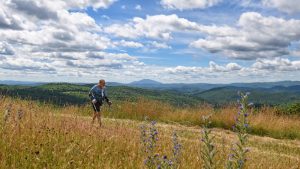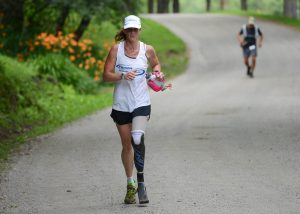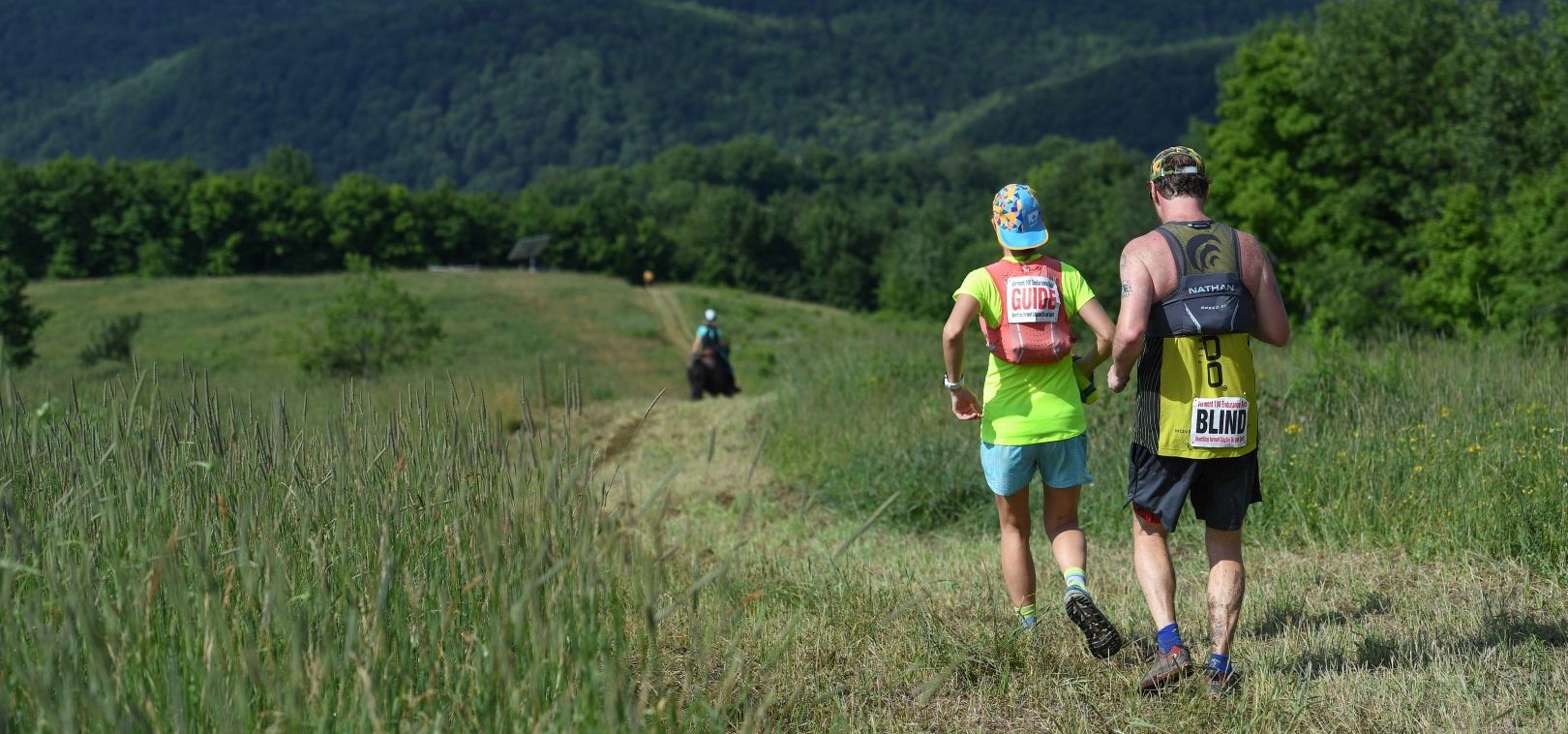ATHLETES WITH DISABILITY – DIVISIONS & RULES
In 2017, the VT100 deepened our commitment to adaptive sports by becoming the first trail ultra ever to recognize mobility and visually impaired athletes in their own division: Athletes With Disabilities (AWD).
This page, as well as our FAQs, cover everything you need to know about the AWD division, from entry criteria to division breakdown to racer and guide rules.
If there is anything you feel we miss here, please contact us. We are happy to help. Or, if you are simply looking for general race information, visit our Race Entry or Race Details pages for all things Vermont 100.
Criteria for entry into the VT 100 AWD category is as follows:
- AWDs must be able to run the course.
- Tethers may be used for athletes with a visually impairment.
- Leg prosthetics may be used for amputees.
- Crutches, braces, or poles may be used if indicated/necessary, with notification to the RD.
- Since there are plenty of mucky Vermont trails on-course, it is not suitable for athletes in wheelchairs (see more on this below).
- AWDs must be able to finish within the 30 hour cutoff (100 mile) or 20 hour cutoff (100km).
- Further details on who qualifies as an AWD is included below.

To underline our value of promoting a strong field of AWDs, all AWDs are invited to register early. All past AWD participants are on the early reg list. Contact the RD if you are an AWD who has not done VT100 before, so we can include you on the early registration invite.
Based on International Paralympic Committee impairment descriptions, the VT 100 will *recognize two types of AWDs based on clearly defined eligible impairments: Visually impaired and mobility impaired.
*Depending on number of AWDs registered, the VT100 may choose to group all AWDs within one division or recognize each division listed below individually:
1. VISUAL IMPAIRED DIVISION
Individuals with vision impacted by an impairment of the eye structure, optical nerves or optical pathways, or the visual cortex, may be granted registration as an AWD but will not be allowed extended time on the course.
A couple things to note about our course for visually impaired athletes:
- Course Markings
The Vermont 100 uses colored plates (yellow) to mark the course during the day and glow sticks (yellow) to mark the course at night. AWDs, with assistance from their guide as needed, must be able to follow the course as marked. Unfortunately, the Vermont 100 is not able make accommodations for athletes with visual impairments by altering the standard course markings. - Canines
In general, dogs aren’t allowed at Silver Hill or at other venues associated with the VT100 (aid stations, race course, etc.). If an athlete with a visual impairment requires a guide dog, please contact Race Director for notification regarding having guide dog at Silver Hill and the aid stations. Again, dogs will only be allowed at the start/finish grounds and designated aid stations but we need a heads up. Dogs will still not be allowed on the course.
2. MOBILITY IMPRAIRED DIVISION
Individuals with permanent physical disabilities that affect their ability to walk/run, may be granted registration as an AWD but will not be allowed extended time on the course.
This includes:
- Limb deficiency
Total or partial absence of bones or joints as a consequence of trauma (e.g. car accident), illness (e.g. bone cancer) or congenital limb deficiency (e.g. dysmelia). - Leg length difference
Bone shortening in one leg due to congenital deficiency or trauma. - Short stature
Reduced standing height due to abnormal dimensions of bones of upper and lower limbs or trunk, for example due to achondroplasia (dwarfism) or growth hormone dysfunction.
Unfortunately, due to course restrictions and safety concerns related to the trails of the VT100, this does not include:
- *Athletes in wheelchairs and duo teams in hand cycles, push-rim cycles, or racing wheelchairs.
*All AWDs must be fully ambulatory, the use of any mechanical device will not be allowed.
AWDs and their guide(s) will follow the same rules as all participants:
Start times, Course, and Time Limits
- AWDs will start with the rest of the athletes for their race (4:00am. for 100 mile, 9:00am for 100km).
- AWDs will run the same course as the rest of the athletes.
- The course time limit is the same for AWDs as for all participants for their race (20 hours for 100km, 30 hours for 100 mile).
Guide Rules
- Guides are expected to follow the same rules as all other pacers.
- AWDs may be accompanied by one guide at a time to complete the VT 100. Accommodations may be made if an AWD requires more than one guide at a time.
- Guide exchanges will take place at crew-accessible aid stations. Accommodations may be made for exchanges at other manned aid stations upon request.
- Athletes are responsible for bringing their own guides to the race, but can reach out for support if they need additional guides to be located.
- Guides are not official entrants in the VT100 and are not timed, scored, or listed in the official results. If a guide wants to be officially timed, scored and listed in results, they need to register as a VT100 participant including paying entry fees and qualifying for the event.
- Guides participate free of charge, but must sign a waiver prior to participation.
- Athlete and guide are regarded as a team and must be together at all times along the course.
- Guides must wear a GUIDE bib on the front and back of their outermost layer, kept visible at all times.
- Guides may not use a bicycle or other mechanical means of transport.
- Guides cannot pull the athlete, or propel the athlete forward by pushing.
- Guides cannot mule for the athlete, or run ahead to aid stations to fill water bottles or otherwise unfairly advantage their athlete.
- Guides must adhere to the same standards as Pacers (see Runner Handbook for full rules)
- Guide may have a drop bag, separate from their athletes drop bag, at aid stations that allow drop bags.
- Guides are encouraged to attend the pre-race briefing on Friday at 4:15pm, however it is ultimately the AWD’s responsibility to attend the meeting and inform their crew and guides of all race rules/regulations.
Guide Responsibilities
- Assure that drop bags (the guide’s’ and AWD’s) are placed in the correct corral in the staging area, immediately following the race briefing.
- Work with AWDs to ensure safety of the AWD. This includes communication between the AWD and guide to stay out of the way (typically running on the side of the trail/road) when being approached from behind by horses, faster runners, or officials on the course in order to avoid collisions.
Looking Forward to a Tremendous Race!

Thank you for taking the time to read this page and for getting familiar with our AWD division. At the end of the day, it is our hope that in disallowing extra time to complete the race (as well as other accommodations), we’re providing an opportunity for all abilities to compete on equal ground.
We’re open to feedback and improvements, and encourage other Race Committees to accept this challenge as well.
See you at the start line!
-The VT100 Race Committee


